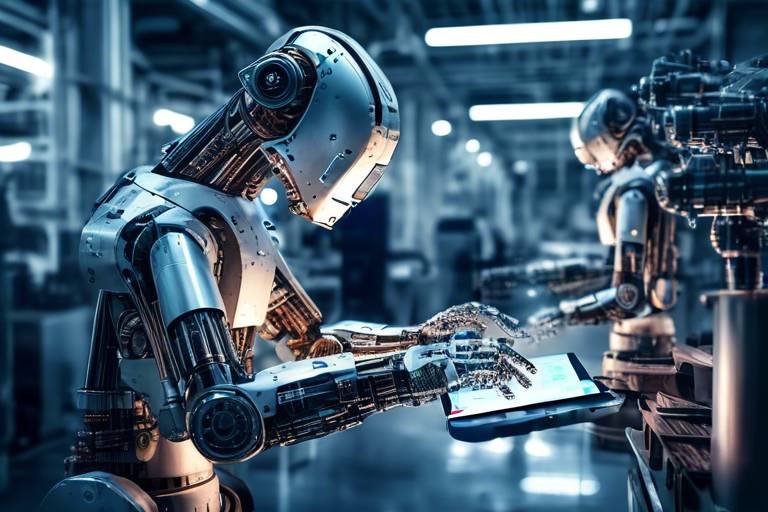How AI Can Tackle World Hunger
In a world where nearly 800 million people go to bed hungry each night, the need for innovative solutions to combat food scarcity has never been more pressing. Enter artificial intelligence (AI), a powerful tool that is revolutionizing the way we approach agriculture and food distribution. Imagine a future where AI not only helps farmers grow more food but also ensures that the food reaches those who need it most. This article explores the innovative ways artificial intelligence can address global food scarcity, enhance agricultural productivity, and improve food distribution systems to alleviate hunger worldwide.
Artificial intelligence is transforming agriculture by optimizing crop yields, predicting weather patterns, and managing resources efficiently. With the help of AI, farmers can now make data-driven decisions that lead to sustainable farming practices. This means healthier crops, reduced environmental impact, and ultimately, a significant reduction in hunger. Think of AI as a farmer's best friend—always there to provide insights that can help maximize productivity while minimizing waste.
At the heart of AI's impact on agriculture is its ability to leverage vast amounts of data. By analyzing everything from soil conditions to market trends, AI equips farmers and policymakers with the information they need to make informed decisions. This data-driven approach enables more effective resource allocation, better planting schedules, and a clearer understanding of market demands. As a result, food security is improved, and the risk of hunger is significantly lowered.
Precision farming is one of the most exciting applications of AI in agriculture. It uses advanced algorithms to analyze soil health, moisture levels, and crop conditions, allowing farmers to implement targeted interventions. For instance, instead of watering an entire field, farmers can use AI to determine exactly where and how much water is needed, leading to increased productivity and reduced waste. This approach not only saves resources but also maximizes crop yields, making it a game-changer in the fight against hunger.
Drones equipped with AI capabilities are another revolutionary tool in modern agriculture. These flying robots can monitor crop health and assess land conditions from above, providing farmers with real-time insights that enhance their agricultural practices. Imagine being able to spot a pest infestation or nutrient deficiency before it becomes a major problem—drones make this possible. By enabling farmers to act quickly, drones help ensure that crops thrive, contributing to a more stable food supply.
Water is a precious resource, especially in farming. AI-driven irrigation systems are optimizing water usage by analyzing weather forecasts and soil moisture levels. This means that crops receive the right amount of water at the right time, reducing waste and promoting healthier plants. Picture a farmer who no longer has to guess when to water their fields; instead, they can rely on AI to take the guesswork out of irrigation, leading to better yields and less water consumption.
Beyond the fields, AI is enhancing food distribution networks by predicting demand, reducing waste, and ensuring that food reaches those in need more efficiently. In both urban and rural areas, AI can analyze consumption patterns and logistics, enabling food suppliers to make smarter decisions about where and when to send food. This optimization not only helps combat hunger but also reduces the carbon footprint associated with food transportation.
Food waste is a significant contributor to hunger, with approximately one-third of all food produced globally going to waste. AI technologies can analyze consumption patterns and optimize food production, helping to minimize waste across the supply chain. By ensuring that more food is available for those in need, AI plays a vital role in the fight against hunger.
AI systems can predict inventory needs for retailers and suppliers, reducing overproduction and ensuring that food items are sold before they expire. This not only helps businesses save money but also means that less food ends up in landfills. Imagine a grocery store that knows exactly how much of each product to stock—thanks to AI, this is becoming a reality, leading to a more efficient food system.
Understanding consumer preferences through AI can help businesses tailor their offerings, reducing food waste and ensuring that surplus food is redirected to those facing hunger. By analyzing data on buying habits, AI can help identify trends and adjust inventory accordingly, ensuring that food is consumed rather than wasted.
- How does AI help farmers? AI helps farmers by providing insights into crop health, optimizing resource use, and predicting weather patterns.
- Can AI reduce food waste? Yes, AI can analyze consumption patterns and optimize production to minimize waste across the supply chain.
- What role do drones play in agriculture? Drones equipped with AI monitor crop conditions and provide real-time insights to farmers, helping them make informed decisions.
- How does AI improve food distribution? AI enhances food distribution by predicting demand and optimizing logistics, ensuring food reaches those in need efficiently.

AI in Agriculture
Artificial intelligence is revolutionizing the agricultural sector, bringing forth a wave of innovation that is reshaping how we grow food. Imagine a world where farmers can predict the best times to plant their crops, where every drop of water is used efficiently, and where pests are managed without harmful chemicals. Sounds like a dream, right? Well, with AI, this dream is becoming a reality. By leveraging advanced algorithms and vast amounts of data, AI is enabling farmers to optimize their crop yields, predict weather patterns, and manage their resources more effectively, which is crucial in the fight against global hunger.
One of the most significant benefits of AI in agriculture is its ability to enhance sustainable farming practices. Traditional farming methods often lead to overuse of resources, soil degradation, and increased carbon footprints. However, with AI, farmers can implement practices that not only boost productivity but also protect the environment. For instance, AI systems can analyze soil health and moisture levels, allowing farmers to make informed decisions about when and how much to irrigate their fields. This targeted approach not only conserves water but also ensures that crops receive the nutrients they need to thrive.
Moreover, AI-driven technologies such as precision farming are changing the game. Precision farming uses data from various sources, including satellite imagery and sensor data, to provide real-time insights into crop conditions. Farmers can monitor their fields from above, identifying areas that need attention, such as those affected by pests or diseases. This means that interventions can be applied precisely where needed, reducing waste and maximizing yield. For example, instead of spraying pesticides over an entire field, farmers can target only the affected areas, minimizing chemical use and promoting a healthier ecosystem.
Another exciting development is the integration of drone technology in agriculture. Drones equipped with AI capabilities can survey vast areas of farmland quickly and efficiently. They can capture high-resolution images and analyze crop health, enabling farmers to make data-driven decisions. This not only saves time but also provides a level of detail that was previously unattainable. Imagine being able to see your entire farm from the sky and pinpointing exactly where your crops need help—it's like having a bird's-eye view of your agricultural empire!
Furthermore, automated irrigation systems powered by AI are transforming how farmers manage water resources. These systems can analyze weather forecasts and soil moisture levels to determine the optimal amount of water needed for crops. This means no more guesswork; farmers can ensure that their plants receive just the right amount of water at the right time, which is essential for growth and sustainability. In regions facing water scarcity, such innovations are not just beneficial—they are vital for survival.
In summary, AI is not just a technological advancement; it is a powerful tool that can help us tackle some of the most pressing challenges in agriculture today. By optimizing crop yields, enhancing sustainability, and improving resource management, AI is paving the way for a future where food scarcity becomes a thing of the past. As we continue to explore and implement these technologies, the potential to alleviate hunger worldwide grows exponentially.

Data-Driven Decision Making
In the age of technology, the phrase "data is king" has never been more relevant, especially when it comes to tackling world hunger. Artificial Intelligence (AI) harnesses the power of vast datasets to provide insights that were previously unimaginable. Imagine a farmer standing in the middle of a vast field, equipped not just with traditional tools, but with a digital assistant that can analyze soil conditions, predict weather patterns, and suggest the best times to plant and harvest. This is the reality of .
AI leverages big data to inform farmers and policymakers, allowing them to make decisions that are not only timely but also effective. For instance, by analyzing historical data on crop yields, weather conditions, and market trends, AI can recommend optimal planting schedules that align with environmental factors. This isn't just about increasing productivity; it's about creating a sustainable future where food scarcity is a thing of the past.
Moreover, data-driven decision making extends beyond the fields. It plays a crucial role in resource allocation. Policymakers can utilize AI to identify regions that are most vulnerable to food insecurity, enabling them to direct resources where they are needed most. This targeted approach can significantly enhance food security across different demographics and regions. Consider this: if a government knows that a particular area is facing drought conditions, it can preemptively allocate water resources and food aid to mitigate the impact. This proactive stance is key in combating hunger effectively.
To illustrate the impact of data-driven decision making, let's take a look at a simplified example in a table format:
| Data Source | AI Application | Outcome |
|---|---|---|
| Weather Forecasts | Predictive Analytics | Optimal Planting Times |
| Soil Health Data | Soil Analysis Algorithms | Improved Crop Yields |
| Market Trends | Consumer Demand Forecasting | Reduced Food Waste |
This table highlights how various data sources can be transformed into actionable insights through AI technology. Each application leads to tangible outcomes that not only enhance agricultural practices but also contribute to a more efficient food distribution system.
Additionally, AI can help farmers understand the intricacies of their local ecosystems. By analyzing data on pest populations, moisture levels, and nutrient content, farmers can make informed decisions about when to apply fertilizers or pesticides, minimizing environmental impact while maximizing crop health. It's like having a crystal ball that helps foresee challenges and opportunities in the agricultural landscape.
In conclusion, the integration of AI into agriculture and food policy is revolutionizing how we approach the issue of hunger. By making data-driven decisions, we can create a more resilient and efficient food system. This isn't just about feeding the world; it's about ensuring that everyone has access to nutritious food, paving the way for a healthier future.
- How does AI help in agriculture?
AI optimizes crop yields, predicts weather patterns, and manages resources efficiently, leading to sustainable farming practices. - What is data-driven decision making?
It refers to the process of making decisions based on data analysis and interpretation, rather than intuition or observation alone. - Can AI reduce food waste?
Yes, AI can analyze consumption patterns and optimize food production, helping to minimize waste across the supply chain.

Precision Farming Techniques
Precision farming is a revolutionary approach that harnesses the power of artificial intelligence to optimize agricultural practices. Imagine being able to know exactly how much water, fertilizer, or pesticide your crops need at any given moment. With precision farming techniques, this is no longer just a dream but a reality. This method involves using advanced technologies such as satellite imagery, sensor data, and machine learning algorithms to create a detailed understanding of the farm's conditions. By analyzing factors like soil health, moisture levels, and crop conditions, farmers can make informed decisions that lead to increased productivity and reduced waste.
One of the most exciting aspects of precision farming is the ability to apply targeted interventions. For instance, instead of blanket applying fertilizers across an entire field, AI can help identify specific areas that need more nutrients. This not only improves crop yield but also minimizes the environmental impact of over-fertilization. In fact, studies have shown that precision farming can increase crop yields by up to 30%! It's like having a personal coach for your crops, guiding you on the best practices to ensure they thrive.
Moreover, the integration of drone technology has taken precision farming to new heights—literally! Drones equipped with AI capabilities can fly over fields, capturing high-resolution images that reveal the health of crops from above. These insights allow farmers to spot problems early, such as pest infestations or nutrient deficiencies, and address them before they escalate. It's akin to having a bird's-eye view of your farm, enabling proactive measures rather than reactive ones.
Another crucial aspect of precision farming is the use of automated irrigation systems. These systems utilize AI to analyze weather forecasts and real-time soil moisture data, ensuring that crops receive the optimal amount of water. This is particularly important in regions prone to drought, where every drop counts. By optimizing water usage, farmers can conserve resources while ensuring their crops remain healthy and productive.
| Technique | Description | Benefits |
|---|---|---|
| Soil Health Monitoring | Analyzing soil composition and nutrient levels. | Improves crop yield and reduces chemical usage. |
| Weather Prediction | Using AI to forecast weather patterns. | Helps in planning planting and harvesting schedules. |
| Yield Mapping | Mapping crop yields across different field zones. | Identifies areas needing attention for better production. |
In conclusion, precision farming techniques are not just a trend; they are a necessity for the future of agriculture. By leveraging AI, farmers can make smarter decisions, enhance productivity, and contribute to global food security. The benefits extend beyond just the farm gate, impacting communities and economies as a whole. As we continue to face challenges such as climate change and population growth, the adoption of these innovative practices will be crucial in tackling world hunger.
- What is precision farming? Precision farming is an agricultural approach that uses technology and data analysis to optimize crop production and resource usage.
- How does AI help in precision farming? AI analyzes data from various sources to provide insights on soil health, moisture levels, and crop conditions, enabling targeted interventions.
- What are the benefits of using drones in farming? Drones provide real-time monitoring of crop health, allowing farmers to detect issues early and manage their fields more effectively.
- Can precision farming reduce environmental impact? Yes, by minimizing the use of fertilizers and water, precision farming practices help reduce the environmental footprint of agriculture.

Drone Technology in Farming
This article explores the innovative ways artificial intelligence can address global food scarcity, enhance agricultural productivity, and improve food distribution systems to alleviate hunger worldwide.
Artificial intelligence is transforming agriculture by optimizing crop yields, predicting weather patterns, and managing resources efficiently, leading to sustainable farming practices that can significantly reduce hunger.
AI leverages vast amounts of data to inform farmers and policymakers, enabling more effective decision-making regarding resource allocation, planting schedules, and market trends, ultimately improving food security.
Precision farming uses AI to analyze soil health, moisture levels, and crop conditions, allowing farmers to apply targeted interventions that boost productivity and minimize waste.
Imagine soaring high above vast fields, where every inch of land is monitored with precision—that’s the power of . Drones equipped with artificial intelligence are revolutionizing the way farmers manage their crops. These flying marvels can gather real-time data on crop health, soil conditions, and even pest infestations, providing a bird's-eye view that was once unimaginable.
By utilizing aerial imagery and advanced sensors, farmers can pinpoint areas that require attention, whether it’s a section of crops needing water or a patch suffering from disease. This not only enhances efficiency but also significantly reduces the amount of resources wasted. For instance, instead of watering an entire field, drones can identify dry spots and direct irrigation precisely where it’s needed, ensuring that every drop counts.
Moreover, the integration of AI allows these drones to analyze data over time, leading to predictive insights. Farmers can anticipate issues before they escalate, such as identifying which crops are more susceptible to pests or diseases based on historical data. This proactive approach not only boosts productivity but also contributes to sustainable farming practices.
Here are some key benefits of using drone technology in farming:
- Real-time monitoring: Drones provide instant feedback on crop conditions, allowing for quick interventions.
- Cost-effective: By minimizing waste and optimizing resource use, drones can significantly lower operational costs.
- Data collection: Drones can gather extensive data that can be analyzed to improve future farming practices.
In conclusion, drone technology is not just a trend; it’s a game-changer. By harnessing the power of AI and aerial surveillance, farmers can maximize their yields while minimizing environmental impact. As we continue to face the challenges of global hunger, innovations like these hold the key to a more sustainable and food-secure future.
AI enhances food distribution networks by predicting demand, reducing waste, and ensuring that food reaches those in need more efficiently, thereby combating hunger in urban and rural areas.
AI technologies can analyze consumption patterns and optimize food production, helping to minimize waste across the supply chain and ensuring more food is available for those in need.
AI systems can predict inventory needs for retailers and suppliers, reducing overproduction and ensuring that food items are sold before they expire.
Understanding consumer preferences through AI can help businesses tailor their offerings, reducing food waste and ensuring that surplus food is redirected to those facing hunger.
Q: How do drones improve farming efficiency?
A: Drones provide real-time data on crop health and conditions, enabling farmers to make informed decisions quickly, which enhances efficiency.
Q: Can AI help in reducing food waste?
A: Yes, AI can analyze consumption patterns and optimize production, minimizing waste across the supply chain.
Q: What role does data play in agriculture?
A: Data helps farmers and policymakers make better decisions regarding resource allocation, planting schedules, and market trends, ultimately improving food security.

Automated Irrigation Systems
Imagine a world where farmers no longer have to worry about whether their crops are getting enough water. With the advent of , this vision is becoming a reality. These systems utilize the power of artificial intelligence to monitor and manage water usage with remarkable precision. By analyzing various factors such as soil moisture levels, weather forecasts, and even crop requirements, these systems ensure that each plant receives the optimal amount of water it needs to thrive.
One of the most significant advantages of automated irrigation systems is their ability to conserve water. Traditional irrigation methods often lead to overwatering or underwatering, which can be detrimental to crop health and waste precious resources. In contrast, AI-driven systems can adjust water delivery in real-time based on current weather conditions and soil moisture readings. This not only helps in conserving water but also contributes to sustainable farming practices that are essential in the fight against global hunger.
Furthermore, these systems can be integrated with other technologies, such as drones and sensors, to create a comprehensive farming ecosystem. For example, drones can provide aerial imagery of fields, highlighting areas that may require more attention. When combined with automated irrigation systems, farmers can make informed decisions about where to direct their water resources, ensuring that every drop counts.
To illustrate the effectiveness of automated irrigation systems, consider the following table that compares traditional irrigation methods with automated systems:
| Feature | Traditional Irrigation | Automated Irrigation |
|---|---|---|
| Water Usage | Often excessive and wasteful | Optimized based on real-time data |
| Labor Requirements | High, requires constant monitoring | Low, automated systems manage irrigation |
| Crop Health | Variable, dependent on manual effort | Consistent, tailored to specific crop needs |
| Sustainability | Less sustainable due to water waste | Highly sustainable, conserves water |
In addition to improving efficiency and sustainability, automated irrigation systems can also enhance crop yields. By ensuring that crops receive the right amount of water at the right time, farmers can maximize their harvests and reduce the risk of crop failure. This is especially crucial in regions where water scarcity is a pressing issue. With AI at the helm, farmers are better equipped to navigate the challenges of climate change and unpredictable weather patterns.
As we move towards a future where technology and agriculture go hand in hand, automated irrigation systems stand out as a beacon of hope. They not only improve the lives of farmers but also play a significant role in addressing the global hunger crisis. By utilizing these innovative systems, we can pave the way for a more sustainable and food-secure world.
- What is an automated irrigation system?
An automated irrigation system uses technology and AI to manage water delivery to crops efficiently. - How does AI improve irrigation?
AI analyzes data such as soil moisture and weather forecasts to optimize water usage, ensuring crops receive adequate hydration. - Are automated irrigation systems cost-effective?
While the initial investment may be high, the long-term savings on water and labor costs make them a wise choice for many farmers. - Can automated irrigation systems be used in all types of farming?
Yes, they can be adapted for various agricultural settings, from small farms to large commercial operations.

Supply Chain Optimization
When we think about tackling world hunger, one of the most critical areas that often gets overlooked is the food supply chain. This is where artificial intelligence (AI) steps in, acting like a superhero for our food systems. Imagine a world where food doesn’t just sit in warehouses or get wasted because it’s not delivered on time. Instead, it flows smoothly from farms to tables, reaching those who need it most. AI is revolutionizing the way we manage food distribution, ensuring that every bite counts.
At the heart of this transformation is AI's ability to predict demand. By analyzing historical data, weather patterns, and even social media trends, AI can forecast what food items will be in demand at any given time. This means that farmers and suppliers can adjust their production schedules accordingly. For instance, if AI predicts a spike in demand for tomatoes next month due to a popular cooking trend, farmers can plant more, ensuring that no one goes without their favorite ingredients.
Moreover, AI plays a pivotal role in reducing food waste. Did you know that roughly one-third of all food produced globally is wasted? That’s a staggering statistic! AI helps combat this issue by optimizing the entire supply chain. By employing algorithms that analyze consumption patterns, businesses can make informed decisions about how much food to produce and when to deliver it. This not only minimizes waste but also ensures that food is available for those in need. For example, if a grocery store knows that certain items are nearing their expiration date, AI can suggest discounts or promotions to encourage sales before the food goes bad.
Another fascinating application of AI in supply chain optimization is its ability to enhance logistics. AI systems can analyze traffic patterns, weather conditions, and delivery routes to determine the most efficient way to transport food. Picture this: a truck loaded with fresh produce can adjust its route in real-time to avoid traffic jams or road closures, ensuring that the food arrives at its destination fresh and on time. This level of efficiency not only helps food reach consumers faster but also reduces transportation costs, making food more affordable.
To illustrate the impact of AI on supply chain optimization, consider the following table that summarizes key benefits:
| Benefit | Description |
|---|---|
| Demand Forecasting | AI predicts food demand based on data analysis, helping producers adjust their output. |
| Waste Reduction | By optimizing production and distribution, AI minimizes food waste throughout the supply chain. |
| Logistics Efficiency | AI enhances transportation routes, ensuring timely delivery of fresh food. |
In conclusion, the optimization of the food supply chain through AI is not just a technological advancement; it’s a crucial step towards eradicating hunger. By making food distribution smarter, we can ensure that resources are allocated efficiently, waste is minimized, and ultimately, that everyone has access to the food they need. Imagine a world where no one goes hungry, where every meal is a result of intelligent planning and execution. That’s the future AI is helping us build.
- How does AI predict food demand? AI analyzes historical data, weather patterns, and current trends to forecast demand accurately.
- What role does AI play in reducing food waste? AI helps optimize production and distribution, ensuring that food is sold before it expires.
- Can AI improve logistics in food distribution? Yes, AI can analyze traffic and weather data to create the most efficient delivery routes.

Food Waste Reduction
Food waste is a colossal issue that affects not only our environment but also the very fabric of society, especially in the fight against hunger. Did you know that approximately one-third of all food produced globally is wasted? That's around 1.3 billion tons of food every year! This staggering amount could feed billions of people. Enter artificial intelligence—a technology that is becoming a game-changer in the quest to reduce food waste and ensure that more food reaches those who need it.
AI technologies analyze consumption patterns and optimize food production, helping to minimize waste across the supply chain. By leveraging data, AI can predict demand more accurately, allowing producers to align their output with actual consumer needs. This means that farmers can plant just the right amount of crops, retailers can stock their shelves more effectively, and consumers can make better purchasing decisions. The result? Less food goes uneaten, and more people have access to nutritious meals.
One of the most exciting applications of AI in food waste reduction is through smart inventory management. Imagine a system that can tell a grocery store exactly how much of each product to order based on historical sales data, seasonal trends, and even local events. This technology not only reduces overproduction but also ensures that food items are sold before they expire. For instance, if a supermarket knows that a big local event is happening, it can adjust its stock accordingly to meet the increased demand. This proactive approach can significantly cut down the amount of food that ends up in landfills.
Moreover, AI can analyze consumer behavior to understand preferences and buying habits. By doing so, businesses can tailor their offerings to match what customers actually want. For example, if AI detects that a certain type of vegetable is consistently being overlooked, suppliers can adjust their inventory to focus on more popular items. This not only reduces waste but also enhances customer satisfaction, as shoppers find what they actually want to buy.
Another innovative approach involves the use of food redistribution networks. AI can help identify surplus food in restaurants, grocery stores, and farms. By connecting these surplus supplies with local food banks and charities, we can ensure that perfectly good food doesn’t go to waste. This creates a win-win situation where businesses can reduce waste disposal costs, and communities can benefit from the additional food resources. In fact, many cities are now implementing AI-driven platforms that streamline this process, making it easier than ever to connect surplus food with those in need.
To visualize the impact of AI on food waste, let’s look at a simple table that summarizes its benefits:
| AI Application | Benefit |
|---|---|
| Smart Inventory Management | Reduces overproduction and ensures timely sales |
| Consumer Behavior Analysis | Tailors offerings to match demand, minimizing waste |
| Food Redistribution Networks | Connects surplus food with local charities, reducing waste |
In conclusion, the potential of AI in reducing food waste is immense. By optimizing inventory, analyzing consumer behavior, and facilitating food redistribution, we can make significant strides toward alleviating hunger. The integration of AI into our food systems not only makes sense economically but also serves a greater social good. As we continue to innovate and harness the power of technology, we move closer to a world where hunger is a distant memory, and food waste is a thing of the past.
Q: How can AI help in reducing food waste?
AI can analyze data on consumption patterns, optimize inventory, and connect surplus food with those in need, significantly reducing waste across the food supply chain.
Q: What are some examples of AI applications in food waste reduction?
Examples include smart inventory management systems, consumer behavior analysis tools, and platforms that facilitate food redistribution.
Q: Can AI really make a difference in global hunger?
Yes! By optimizing food production and distribution, AI can ensure that more food reaches those in need, helping to alleviate hunger worldwide.

Smart Inventory Management
This article explores the innovative ways artificial intelligence can address global food scarcity, enhance agricultural productivity, and improve food distribution systems to alleviate hunger worldwide.
Artificial intelligence is transforming agriculture by optimizing crop yields, predicting weather patterns, and managing resources efficiently, leading to sustainable farming practices that can significantly reduce hunger.
AI leverages vast amounts of data to inform farmers and policymakers, enabling more effective decision-making regarding resource allocation, planting schedules, and market trends, ultimately improving food security.
Precision farming uses AI to analyze soil health, moisture levels, and crop conditions, allowing farmers to apply targeted interventions that boost productivity and minimize waste.
Drones equipped with AI can monitor crop health and assess land conditions from above, providing farmers with real-time insights to enhance their agricultural practices.
AI-driven irrigation systems optimize water usage by analyzing weather forecasts and soil moisture levels, ensuring crops receive the right amount of water at the right time.
AI enhances food distribution networks by predicting demand, reducing waste, and ensuring that food reaches those in need more efficiently, thereby combating hunger in urban and rural areas.
AI technologies can analyze consumption patterns and optimize food production, helping to minimize waste across the supply chain and ensuring more food is available for those in need.
In the realm of food distribution, powered by AI is a game changer. Imagine a system that can predict exactly how much food a grocery store will need based on historical data, seasonal trends, and even local events. This is not just a dream; it’s becoming a reality. AI systems can analyze patterns in consumer behavior, allowing retailers to adjust their inventory dynamically. For instance, if a local festival is approaching, the system can suggest increasing stock for popular items, thereby reducing the risk of shortages.
Moreover, these smart systems can help prevent overproduction, which is a significant contributor to food waste. By accurately forecasting demand, retailers can avoid ordering excess products that may go unsold and eventually spoil. A study by the Food Waste Reduction Alliance found that nearly 40% of food in the U.S. is wasted, a staggering statistic that AI can help mitigate. The implementation of AI in inventory management can be illustrated in the following table:
| Traditional Inventory Management | AI-Driven Inventory Management |
|---|---|
| Relies on historical sales data | Analyzes real-time data and trends |
| Manual stock checks | Automated inventory tracking |
| Higher rates of food spoilage | Minimized waste through accurate predictions |
| Static ordering processes | Dynamically adjusts orders based on demand |
In addition to reducing waste, AI also helps streamline the process of redirecting surplus food to those who need it most. By analyzing data on local charities and food banks, AI can facilitate connections between surplus food sources and organizations that can distribute it to hungry communities. This not only helps in reducing waste but also ensures that food is reaching the plates of those who are facing hunger.
- How does AI help reduce food waste? AI analyzes consumption patterns and optimizes inventory management to prevent overproduction and ensure timely distribution of food.
- What is precision farming? Precision farming uses AI to analyze various factors affecting crop health, allowing farmers to make informed decisions and increase yields.
- Can AI predict food demand? Yes, AI systems can analyze historical data and current trends to accurately forecast food demand, helping to optimize supply chains.

Consumer Behavior Analysis
Understanding consumer behavior is like peering into a crystal ball that reveals not just what people want to eat, but also when and how they prefer to consume it. With the help of artificial intelligence, businesses can gain invaluable insights into the preferences and habits of consumers, allowing them to make informed decisions that can significantly reduce food waste. Imagine a world where food producers and retailers can anticipate demand with pinpoint accuracy, adjusting their offerings to match consumer tastes in real-time. This is not just a dream; it’s becoming a reality thanks to AI.
AI technologies analyze vast amounts of data, including purchasing patterns, seasonal trends, and even social media sentiment, to understand what consumers want. For instance, if a sudden trend emerges for plant-based diets, AI can alert producers to ramp up production of relevant products before the demand skyrockets. This proactive approach not only helps in meeting consumer needs but also minimizes the risk of overproduction, which is a significant contributor to food waste.
Moreover, AI can segment consumers into distinct groups based on their buying habits. By using clustering algorithms, businesses can identify different consumer profiles, such as health-conscious individuals, budget shoppers, or gourmet food enthusiasts. This segmentation allows companies to tailor their marketing efforts and product offerings, ensuring that they align closely with the preferences of each group. For example, a retailer might promote organic fruits and vegetables to health-conscious consumers while offering discounts on staple items to budget shoppers.
Additionally, AI can enhance the customer experience by providing personalized recommendations. Think of it as having a personal shopper who knows your likes and dislikes, suggesting products you didn’t even know you wanted. This level of personalization not only increases customer satisfaction but also encourages repeat purchases, ultimately leading to less food waste as consumers are more likely to buy what they will actually consume.
However, the impact of AI goes beyond just improving sales and reducing waste. It also plays a crucial role in redistributing surplus food. By analyzing consumer buying patterns, AI can help identify when and where excess food is likely to be available. This information can be used to connect retailers with food banks or charities, ensuring that surplus food is redirected to those in need rather than ending up in landfills. In this way, AI not only aids businesses but also contributes to social good.
To summarize, consumer behavior analysis powered by AI is a game-changer in the fight against food waste. By leveraging data to understand preferences, businesses can make smarter decisions that not only satisfy customers but also contribute to a more sustainable food system. The ripple effects of these innovations can be profound, helping to ensure that more food reaches those who need it while simultaneously reducing the environmental impact of waste.
- How does AI predict consumer behavior?
AI uses algorithms to analyze data from various sources, including purchase history and social media, to identify patterns and trends in consumer preferences. - Can AI help reduce food waste?
Yes, AI can optimize inventory management and predict demand, helping businesses reduce overproduction and ensure that food is consumed before it expires. - What role does consumer segmentation play?
By segmenting consumers, businesses can tailor their marketing strategies and product offerings, making them more relevant and appealing to different groups. - How can surplus food be redistributed effectively?
AI can analyze data to identify surplus food availability and connect businesses with food banks or charities to ensure it reaches those in need.
Frequently Asked Questions
- How can AI help in increasing agricultural productivity?
AI can significantly boost agricultural productivity by utilizing data analytics to optimize crop yields. By analyzing soil health, moisture levels, and weather patterns, AI enables farmers to make informed decisions on when to plant and how to manage their resources more effectively. This leads to healthier crops and a more sustainable farming approach.
- What role does precision farming play in combating hunger?
Precision farming employs AI technologies to provide targeted interventions based on real-time data. This means farmers can apply the right amount of fertilizers, pesticides, and water exactly when needed, minimizing waste and maximizing yield. Such practices not only increase food production but also help in conserving resources, which is crucial in the fight against hunger.
- How does AI improve food distribution systems?
AI enhances food distribution by predicting demand and optimizing supply chains. By analyzing consumption patterns, AI can help ensure that food reaches those in need efficiently, reducing waste along the way. This is particularly important in urban areas where food scarcity can be a pressing issue.
- Can AI help reduce food waste?
Absolutely! AI technologies can analyze various data points to optimize food production and consumption. By understanding consumer behavior and predicting inventory needs, businesses can reduce overproduction and ensure that surplus food is redirected to those facing hunger, thus minimizing waste.
- What are automated irrigation systems and how do they work?
Automated irrigation systems use AI to determine the optimal amount of water crops need based on real-time data such as weather forecasts and soil moisture levels. This technology ensures that crops receive just the right amount of water at the right time, promoting healthy growth while conserving water resources.
- How do drones contribute to modern farming?
Drones equipped with AI technology can monitor crop health and assess land conditions from an aerial perspective. They provide farmers with valuable insights into their fields, enabling them to make quicker and more informed decisions that enhance agricultural practices and boost productivity.



















